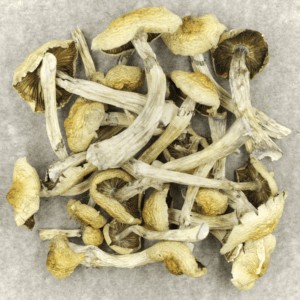
The most potent shrooms in the world are those that contain the highest concentration of the active ingredient psilocybin. Psilocybin is the main psychoactive compound in magic mushrooms, and it is responsible for the majority of the effects that people experience when they consume these mushrooms. There are many different species of magic mushrooms that contain varying amounts of psilocybin, and the potency of the shrooms depends on the specific type of mushroom and the growing conditions. Shop now.
Some of the most potent magic mushrooms include:
Psilocybe cubensis: This is one of the most popular types of magic mushrooms, and it is also one of the most potent. Psilocybe cubensis contains up to 1.78% psilocybin, making it one of the strongest varieties of magic mushrooms.
Psilocybe semilanceata: This type of magic mushroom is also known as the liberty cap, and it is one of the most potent varieties of magic mushrooms. Psilocybe semilanceata contains up to 1.66% psilocybin.
Psilocybe cyanescens: This type of magic mushroom is also known as the wavy cap, and it is one of the most potent varieties of magic mushrooms. Psilocybe cyanescens contains up to 1.58% psilocybin.
Psilocybe azurescens: This type of magic mushroom is also known as the blue ringed octopus, and it is one of the most potent varieties of magic mushrooms. Psilocybe azurescens contains up to 1.53% psilocybin.
How to Grow Mushrooms Healthily
There are a few important things to remember when growing shrooms. First, mushrooms need a dark, humid environment in order to grow. A good way to create this environment is to use a plastic tote with a lid. Second, mushrooms need a substrate, or food source, in order to grow. A good substrate for mushrooms is a mixture of straw and manure. Third, mushrooms need fresh air in order to grow, so it is important to ventilate the tote. Finally, mushrooms need to be watered regularly, but not too much.
Mushroom Myths Debunked
Mushrooms are often feared because of their association with poison and death. However, there are many myths and misconceptions about mushrooms that have led to this fear. Here are some of the most common mushroom myths, and the truth behind them.
Myth: All mushrooms are poisonous.
Fact: Only a small percentage of mushrooms are actually poisonous. In fact, many mushrooms are edible and can be a delicious addition to your diet. There are even some mushrooms that are known for their medicinal properties.
Myth: You can’t tell if a mushroom is poisonous just by looking at it.
Fact: While it’s true that you can’t always tell if a mushroom is poisonous just by looking at it, there are some general characteristics that can help you identify a poisonous mushroom. For example, poisonous mushrooms often have a bright red or orange cap, while edible mushrooms typically have a brown or white cap. Poisonous mushrooms also often have a ring around the stem, while edible mushrooms typically do not.
Myth: Eating a poisonous mushroom will kill you.
Fact: While eating a poisonous mushroom can make you very sick, it is very rare for it to be fatal. In most cases, if you receive treatment soon after eating a poisonous mushroom, you will make a full recovery.
Myth: You can’t get sick from eating a poisonous mushroom if you cook it first.
Fact: This is a common misconception, but it is not true. Cooking a mushroom will not make it safe to eat if it is poisonous. In fact, some poisonous mushrooms actually become more toxic when they are cooked.
Myth: Mushrooms are a type of plant.
Fact: Mushrooms are actually a type of fungus. Fungi are different from plants in a number of ways, including the fact that they do not contain chlorophyll and cannot produce their own food through photosynthesis.
Myth: Mushrooms are just a vegetable.
Fact: While mushrooms are often used as a vegetable in cooking, they are actually classified as a type of fruit. This is because they produce spores instead of seeds.
Hopefully, these mushroom myths have been debunked and you now have a better understanding of these often misunderstood organisms.
Leave a comment